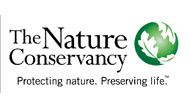

| Visitors Now: | |
| Total Visits: | |
| Total Stories: |

| Story Views | |
| Now: | |
| Last Hour: | |
| Last 24 Hours: | |
| Total: | |
Seven community organizations in Heʻeia ahupuaʻa win the Conservancy’s Kāko‘o ‘Āina Award
 HONOLULU – Seven community partners from Heʻeia in Windward Oʻahu received The Nature Conservancy’s Kāko‘o ‘Āina Award at a community celebration this past weekend at Heʻeia State Park.
HONOLULU – Seven community partners from Heʻeia in Windward Oʻahu received The Nature Conservancy’s Kāko‘o ‘Āina Award at a community celebration this past weekend at Heʻeia State Park.
For the last eight years, the Conservancy has honored individuals who have provided substantial and lasting support for conservation with the Kāko‘o ‘Āina award, which means literally, one who supports the land. This year, the Conservancy departed from tradition to honor a coalition of partners who are working to create a true mountains-to-sea ahupua‘a restoration project in Windward Oʻahu.
“We are inspired by the collective effort of these organizations that have come together to do what a lot of people only talk about: working from mauka to makai to restore a traditional Hawaiian ahupuaʻa,” said Suzanne Case, Executive Director of The Nature Conservancy of Hawaiʻi. “These partners are to be congratulated. The job of restoring an ahupuaʻa is arduous and complex, requiring tremendous patience and cooperation. Their hard work and continuing efforts not only benefit the Heʻeia community, but the entire state.”
Each awardee was given an ‘ō‘ō, or Hawaiian digging stick, made of ʻōhiʻa wood, by artist Mark Hee. The ‘ō‘ō is a traditional Hawaiian farming tool used for turning over soil, digging deep holes, planting, and more. The Nature Conservancy’s senior scientist and cultural advisor, Dr. Sam ‘Ohu Gon III, offered an original oli (Hawaiian chant) honoring the seven representatives of the organizations. The honorees were:
Koʻolaupoko Hawaiian Civic Club, represented by Aunty Mahealani Cypher
- Created the Koʻolaupoko Ahupuaʻa Boundary Marker Project with the State Department of Transportation to raise awareness among Hawaiʻi residents about traditional ahupuaʻa boundaries and their kuleana to mālama – protect – their natural and cultural resources. The project is now being implemented statewide.
- Helped establish Kākoʻo ʻŌiwi and Māhuahua ʻAi o Hoi, a community effort to return productivity to the land and transfer knowledge of traditional land stewardship practices and customs to a new generation.
Papahana Kuaola/Hui Kū Maoli Ola, Rick Barboza
- Hui Kū Maoli is celebrating its 14th year providing native plants from its nursery on 63 acres of land in Waipao, Heʻeia. They have propagated more than 1,000,000 native plants, including 40,000 endangered species, and have introduced 80 species of native Hawaiian plants to the landscaping market.
- Papahana Kuaola has restored 60 acres of native landscape and has created an inspirational educational site with cleared outdoors classrooms, a contemporary heiau, a rain shelter, 57 small loʻi kalo (taro patches), and a native plant nursery.
Kākoʻo ʻŌiwi, Jerry Kaluhiwa, Director
- Kākoʻo ʻŌiwi has cleared 10 acres of natural wetland previously choked by invasive weeds and established two acres of operating loʻi kalo. The community-based non-profit seeks to bring back a prized tradition: Heʻeia as a breadbasket.
- The loi walls are built higher than usual to capture stormwater flow and act as sediment traps, keeping excess run-off and sediment from flowing into the fishpond and bay below it.
Paepae o Heʻeia, Hiʻilei Kawelo, Executive Director
- Paepae o Heʻeia has removed 3,500 feet of invasive mangrove from the fish pond and fully restored 3,000 feet of the 7,000 foot wall. Since 2006, they have removed 37 tons of invasive algae and have cultivated, harvested and sold 2,000 pounds of fish.
- Since its founding in 2001, the group has employed 37 people and 76 interns and welcomed 50,000 volunteers and visitors.
Hawaiʻi Division of Aquatic Resources, Jono Blodgett
- In the last 12 months the Division’s aquatic invasive species team cleared 138,000 pounds of invasive algae from nearly 12 acres of reef in Kāne‘ohe Bay, and then seeded the reefs with native sea urchins that feed on the algae and keep it from growing back.
- The Division is also raising native sea urchins at their Anuenue Fisheries Research Center on Sand Island. Since 2011, they have raised and out planted more than 100,000 urchins.
Hui Ulu Meaʻai, Charles Reppun
- This group of local farmers promote sustainable agriculture in the Koʻolaupoko area and across Hawai‘i. They recycle the invasive algae from Kāneʻohe Bay to use as fertilizer and compost.
- They also have been instrumental in restoration of loʻi kalo and advocating for water rights for farmers.
- Hawaiʻi Institute of Marine Biology, Dr. Jo-Ann Leong, Director
- This world-renowned marine research institute on Moku o Loʻe, or Coconut Island, offers cutting edge research facilities and convenient access to a diverse range of marine environments. The Institute engages in many disciplines of tropical marine science, including coral ecology.
- Since 2005, the Institute has supported the work of the Super Sucker reef restoration project, and it was an Institute graduate student who first experimented with removing invasive algae and using native fish and sea urchins to prevent it from growing back in the bay.
The Nature Conservancy’s Kāko‘o ‘Āina award, was established in 2006. Previous winners include Jan TenBruggencate, a 30-year science and environmental reporter with the Honolulu Advertiser; wildlife biologist and photographer Jack Jeffry; Maui biologist Art Medeiros; the east O‘ahu community group Mālama Maunalua; Molokaʻi cultural and environmental educator Penny Martin; Kauaʻi weed warrior Katie Cassel; and marine scientist Bill Gilmartin, who is credited with saving the Hawaiian monk seal from extinction.
The Nature Conservancy is the leading conservation organization working around the world to conserve the lands and waters on which all life depends. The Conservancy and its more than 1 million members have protected nearly 120 million acres worldwide. Visit The Nature Conservancy on the Web at www.nature.org.
Source: http://www.hawaiireporter.com/seven-community-organizations-in-he%ca%bbeia-ahupua%ca%bba-win-the-conservancys-kakoo-aina-award/123


